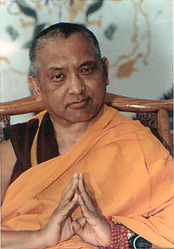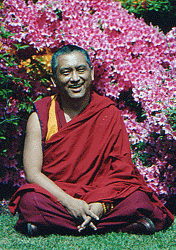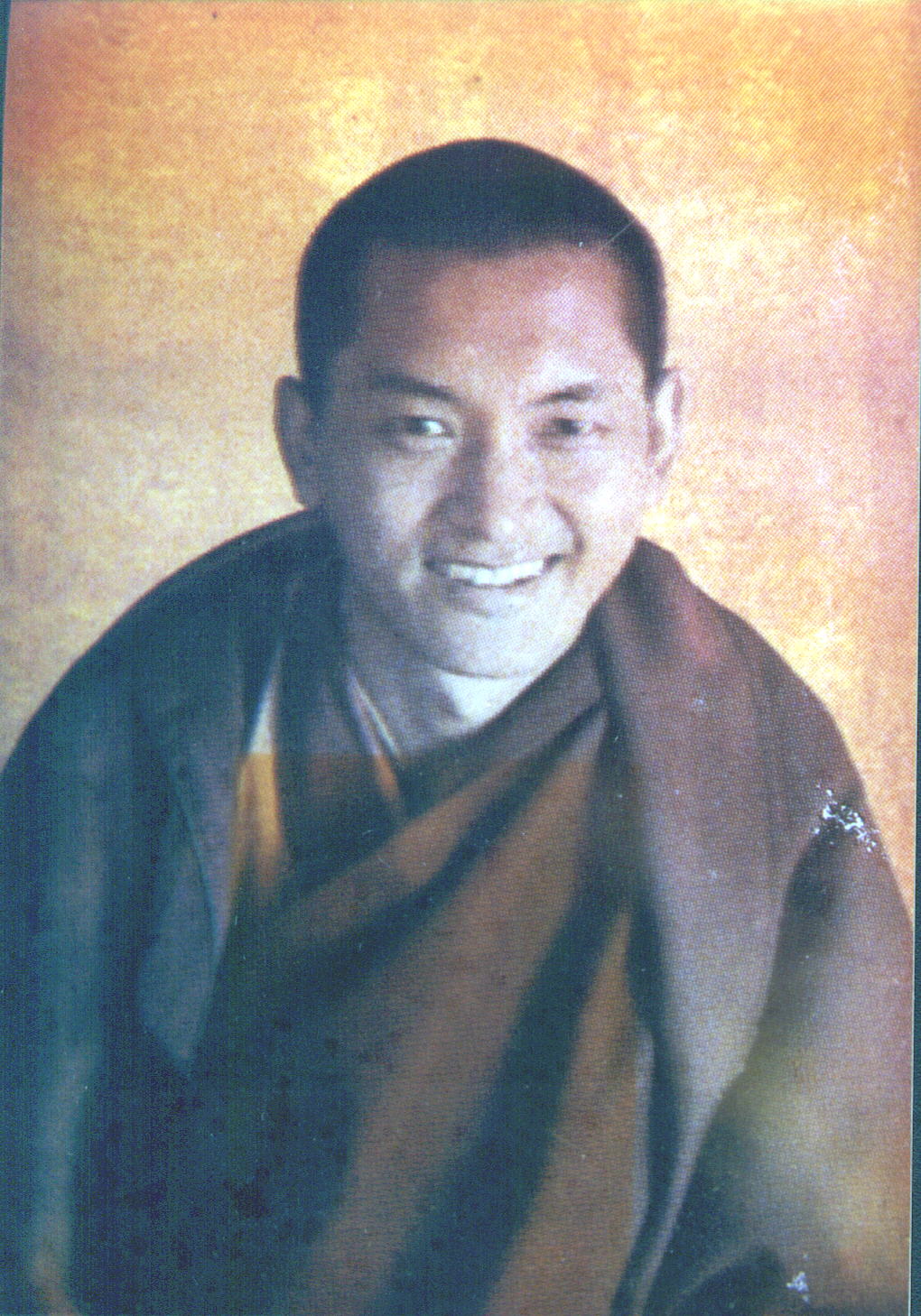
|
Our
Beloved Guru...
The Most Kind Kyabje Zopa Rinpoche |
 |
|
Kyabje Thubten Zopa Rinpoche was born in 1946 in the village of Thami in the Solo Khumbu region of Nepal near Mount Everest. From the house where he was born he could look up the mountainside and see Lawudo, where the cave of the late Lawudo Lama was situated. While his predecessor had belonged to the Sakya tradition of Tibetan Buddhism, the Lawudo Lama himself had been a great master of the complete tantric teachings of the Nyingma tradition. For the last twenty years of his life he had lived in his cave, attended by his wife and two children, and had spent all his time either meditating or giving teachings and spiritual advice to the people of the Solo Khumbu and neighbouring regions. His energy on behalf of all beings was inexhaustible and it is said that in his later years he passed completely beyond the need for sleep. From the time he was able to crawl, Zopa Rinpoche would spend most of his time trying to climb the steep path leading to the cave of this deceased lama. Time and again his family would have to retrieve him forcefully from the precarious route he was intent on travelling and make him return reluctantly to his home. Finally, when he was old enough to speak, he declared that the cave was his and that he was the incarnation of the Lawudo Lama. He further insisted that his only desire was to lead a life of meditation. When he was four or five years old, his claim to be an incarnate lama was subjected to public examination by Ngawang Samden, a Nyingma master meditator who lived nearby. When the young boy was repeatedly able to identify possessions belonging to the Lawudo Lama and pass other rigorous tests, he was formally declared to be the rightful incarnation and received the full investiture of the Nyingma tradition. Later he was to receive the tantric initiations of this tradition from the head lama of the Thami Gompa, known affectionately as Gaga (or Grandfather) Lama. Young Zopa Rinpoche began his education at Solo Khumbu in the traditional Tibetan manner, with the alphabet. One of the first books he read was the biography of Milarepa, the famous eleventh century poet and meditator. This work sparked in him a great desire to become like Milarepa and study under such a highly realised lama as Marpa, Milarepa's root guru. He also heard of the Mindrol Ling Monastery in Tibet, the famous centre preserving and transmitting all the Nyingma teachings and initiations, and wanted very much to go there to pursue his spiritual training. While still a young boy, Zopa Rinpoche was taken on his uncle's back for a pilgrimage to Tibet. When he arrived north of Sikkim at the Dung-kar Monastery of Domo Geshe Rinpoche, he startled his uncle by declaring that he had no intention of returning home with him. Rather, he wanted to stay at this monastery and devote his life to studying and practising the dharma. The uncle was very upset because the young Rinpoche was his responsibility, but when the commissioner of the area decided that the child's wishes should be honoured, there was nothing left for him to do but return to Nepal empty-handed.
(An excerpt taking from the Introduction of Wisdom Energy) Lama Thubten Yeshe and Khabje Thubten Zopa Rinpoche, together as teacher and disciple since their exile in India, met their first Western students in 1965 and by 1971 had settled at Kopan, a small hamlet near Kathmandu in Nepal. In response to the many requests they received, they began teaching Buddhist philosophy and meditation to increasing numbers of travellers, many of whom had come from the west. After studying Buddhism for a while with the lamas, many of these westerners returned home and started groups and centres in their own countries. In 1975, Lama Yeshe named his fledgling network of centres the Foundation for the Preservation of the Mahayana Tradition (FPMT). Now more than 130 centres and other activities in 26 countries make up the FPMT, and it grows yearly.
|
|
"If
you neglect to protect your mind,
you can neither close the door to suffering nor open the door to happiness." |
 |
|
Kyabje
Zopa Rinpoche
|
| Home | Teachers | Dharma-On-Demand | About MBA | News & Events | Membership & Sponsorship | Links | Contact Us |
